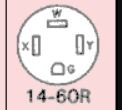Just installed the Tesla wall version 3 and manual states integrated GFCI and no additional required [CCID20]No, "Tesla Wall Connector" is what Tesla calls its EVSE. The current Tesla Wall Connector (version 3, I believe) supports hard-wiring on a 60A circuit to provide 48A continuous to the EV (if its on-board charger is so rated). And putting it on a 60A circuit means that 210.8(F) would not apply.
Cheers, Wayne
Also in bold letters: do not install a GFCI circuit breaker. Unit was hardwired in the garage.

